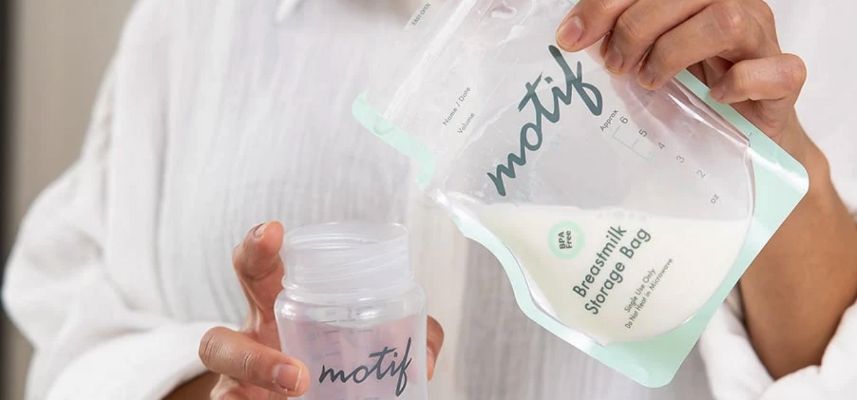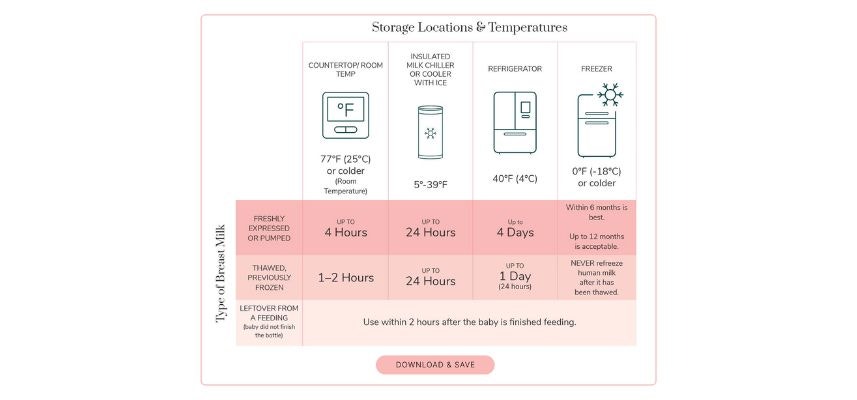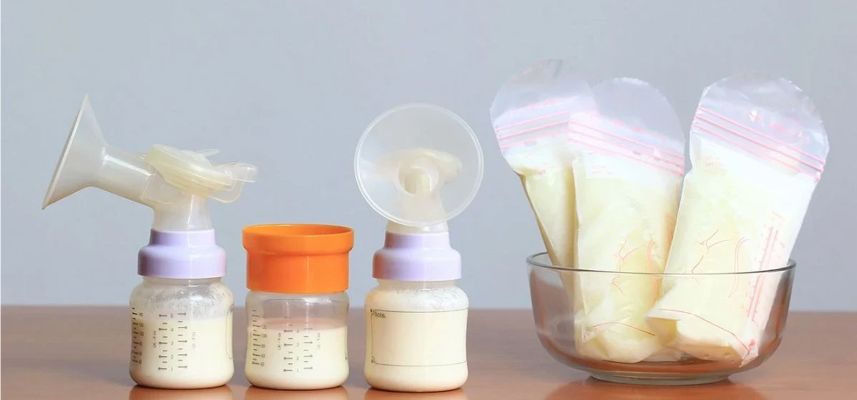Yes, you can safely mix breast milk under specific conditions! In fact, mixing breast milk is a common practice among breastfeeding mothers, especially when building a freezer stash or preparing bottles for daycare. But remember, whether you’re combining freshly pumped breast milk from different sessions, mixing milk from both breasts, or adding fresh milk to your refrigerated supplies, you need to follow proper temperature guidelines and storage protocols.
IN THIS ARTICLE:
When You Can You Safely Mix Breast Milk
When Mixing Breast Milk Requires Extra Caution
What You Cannot Mix with Breast Milk
Guidelines for Storing Breast Milk
Signs Your Mixed Milk Has Gone Bad
Best Practices for Mixing Breast Milk
Maximizing Your Milk Supply Through Smart Mixing
Common Mixing Mistakes to Avoid
Using and Thawing Frozen Breast Milk
Special Considerations for Premature or Sick Babies
Expert Recommendations for Safe Mixing


When You Can You Safely Mix Breast Milk
There are a few ways you can safely mix and store fresh and refrigerated milk. Here's what you need to know.
Combining Freshly Pumped Milk from the Same Pumping Session
The simplest form of mixing involves combining milk from both breasts during a single pumping session. Don’t worry: This is completely safe and recommended, as the milk is at the same temperature and was expressed at the same time!
Mixing Fresh and Refrigerated Milk
You can add freshly pumped milk to previously refrigerated milk, but temperature matters. According to the Centers for Disease Control and Prevention (CDC), you should cool your freshly pumped milk in a separate container in the refrigerator first before combining it with cold milk from previous sessions.
Combining Breast Milk from Different Days
You can safely mix together expressed milk from different days. However, be sure to label the combined container with the date of the oldest milk and follow storage guidelines based on that earlier date. And remember all refrigerated milk should be used or frozen within four days of your initial pumping date.


When Mixing Breast Milk Requires Extra Caution
Keep this in mind before mixing formula or fresh, frozen, and thawed milk:
Fresh and Frozen Milk Combinations
It isn’t a good idea to add freshly expressed milk to frozen milk. Instead, freeze your fresh breast milk in a separate container. Once frozen, thaw the old and new containers at the same time and then combine them into one bottle.
Dr. Jessica Madden, MD, the Medical Director at Aeroflow Breastpumps, emphasizes the importance of proper milk handling. She says, "Maintaining appropriate temperatures when combining milk is crucial for preventing bacterial growth and preserving the nutritional and immunological properties that make breast milk so beneficial."
Previously Thawed Breast Milk
Once frozen milk has been thawed, you can combine it with fresh milk if you’re going to use it immediately. However, if you’re planning on storing the mixture, cool the fresh milk first. Remember thawed milk must be used within 24 hours and cannot be refrozen.
Leftover Milk from Feedings
Don’t put leftover breast milk back in the refrigerator or freezer. Leftover milk can be used within two hours or thrown out. It's also important to know you should never combine any milk that might remain in a bottle after feeding with your fresh or stored milk.
Basically, once your baby has touched the bottle nipple, bacteria from their mouth can contaminate the remaining milk, and that makes it unsafe to mix with your other supplies.
Formula Combinations
While both breast milk and formula are safe for babies individually, mixing them in the same container is generally not recommended (unless your baby is a preemie and a dietician recommends adding formula to breast milk to increase the amount of calories). This is because breast milk and formula have different storage requirements and preparation guidelines.
Dr. Madden, MD, says, "If your baby needs both, offer them separately or in consecutive feedings. When possible, start by feeding your baby breast milk first since any leftover milk or formula will have to be thrown out."
So, if you are mixing breast milk and formula in the same container, make sure the formula is fully prepared according to the manufacturer's instructions before you add any breast milk.
(And always check with your healthcare provider for more personalized advice!)
Donor Milk Considerations
If you’re using donor milk from milk banks, be cautious when combining it with your own milk (we recommend you obtain milk through a milk bank accredited by the Human Milk Banking Association of North America). If you choose to mix donor milk with your own, follow the same cooling protocols and label containers with the date of the oldest milk. However, many lactation experts recommend keeping donor milk separate for tracking purposes.
When Using a Cooler
After expressing milk, you can store it in a cooler or insulated cooler bag with ice packs for about 24 hours. The temperature of your cooler will determine if it will be safe to freeze your milk (the colder, the better).
Remember: Freeze your breast milk within 24 hours of chilling it!
What You Cannot Mix with Breast Milk
Know what to avoid mixing with your milk for safer feeding:
1. Milk Produced While Taking Certain Medications
Many medications are safe to take while breastfeeding! That said, you should avoid mixing milk expressed while taking certain medications with regular milk supplies. If you've taken medications that require "pump and dump" protocols, keep that milk separate and discard it. Similarly, milk expressed after alcohol consumption should not be mixed with regular supplies.
Be sure to consult your healthcare provider for specific guidelines concerning your medications!
2. Water or Other Liquids
Can you mix breast milk with water? The answer is no. You should never dilute breast milk with water, formula powder, or other liquids to increase volume. Doing this changes the nutritional composition and can be dangerous for babies, especially newborns whose kidneys cannot handle diluted milk properly.
3. Spoiled or Questionable Milk
If any portion of your milk smells off, looks unusual, or has been stored improperly (like, it’s been left out too long or stored at the wrong temperature), do not mix it with good milk! Contaminated milk can spoil the entire batch and should be tossed out.
4. Milk from Different Mothers
Beyond the donor milk considerations mentioned above, never mix milk from multiple mothers in the same container. While extremely unlikely, this could put your baby at risk for exposure to harmful diseases or other contaminants in milk that are unsafe for your baby to drink. And because each mother's milk has unique antibodies and nutritional profiles suited to her baby, mixed sources make it impossible to track which mother's milk might cause reactions.
5. Milk from Illness Periods
Some mothers choose to keep milk expressed during certain illnesses separate, though most common colds don't require this precaution. Consult with your healthcare provider about whether milk from illness periods should be thrown out or kept separate from your regular supply.


Guidelines for Storing Breast Milk
Here's what to know about storing your milk at different temperatures:
Refrigerated Breast Milk
Mixed refrigerated milk follows the same guidelines as single-session milk. So, store combined milk in the main body of the refrigerator, away from the door where temperatures fluctuate. Use within four days of the oldest milk's pumping date.
Freezer Storage
If you’re freezing combined milk, make sure all portions are properly cooled before mixing and freezing. Frozen combined milk can be stored safely for up to one year. The CDC recommends using frozen human milk within six months for optimal quality. And don't fill milk bags past the 3/4 mark, since breast milk expands as it freezes.
Room Temperature Guidelines
Mixed milk at room temperature should be used within two hours, following the same timeline as single-session expressed milk. Keep your containers covered and in the coolest part of the room, away from direct sunlight or other heat sources.
Signs Your Mixed Milk Has Gone Bad
Visual and Smell Indicators
Freshly expressed milk should smell slightly sweet or have no odor. Milk that has been frozen may have a higher fat content that gives it a soapy smell. Don’t worry! This doesn’t mean it’s spoiled.
On the other hand, sour, rancid, or metallic smells often indicate spoilage. Visually, spoiled milk may appear chunky, curdled, or have an unusual color. Some separation is normal—gently swirl to remix the cream and milk layers. Your milk might also change colors for a variety of reasons that do not indicate spoilage.
Read about breast milk color variations to learn more!
Taste Changes
While not all mothers taste-test their milk, those who do should note spoiled milk tastes sour or unpleasant. Some frozen milk may develop a soapy taste due to lipase activity, which is safe but might be rejected by some babies.
When in Doubt
If you're unsure about mixed milk safety, it’s best to err on the side of caution and discard it. Trust your instincts! Your baby's safety always takes priority over preserving milk. Don’t hesitate to consult your healthcare provider for specific questions about mixed milk safety.


Best Practices for Mixing Breast Milk
Here's what our experts recommend when storing your milk:
Temperature Management
Always bring milk to similar temperatures before combining. This means:
-
Cooling fresh milk in the refrigerator before adding to cold milk
-
Allowing frozen milk to thaw completely before mixing with refrigerated milk
-
Never mixing warm milk with cold milk directly
-
Thawing the oldest milk first
Labeling Systems
Proper labeling prevents confusion and helps to ensure safety. Follow these simple steps:
-
Date containers with the oldest milk's pumping date
-
Include time of day when relevant. This is because morning vs. evening milk has different hormone profiles
-
Note if milk contains any mixing from different sources
-
Use waterproof labels that won't smudge when wet
Storage Bag and Container Selection
Choose appropriate storage containers for mixed milk, including:
-
BPA-free plastic or glass containers with tight-fitting lids
-
Breast milk storage bags designed for freezing (if planning to freeze mixed milk)
-
Containers sized appropriately for your baby's typical feeding amounts
You can find more detailed storage and preparation advice from the CDC here.
Maximizing Your Milk Supply Through Smart Mixing
Try these best practices to get the most use out of your milk supply!
Pooling Strategies
Many breastfeeding mothers use "pooling" techniques to create larger volumes for storage. This includes:
-
Combining multiple small pumping sessions throughout the day
-
Mixing morning and evening milk to balance hormone content
-
Creating uniform bottles for daycare or babysitters
Dr. Madden, MD, notes, "Efficient milk management, including smart mixing strategies, can reduce stress for new mothers and help them maintain their milk supply longer."
Avoiding Waste
Proper mixing techniques help minimize milk waste. Here are some tips to avoid waste:
-
Combine small amounts from different pumping sessions instead of storing separately
-
Mix milk into baby-appropriate serving sizes
-
Use older mixed milk first to prevent expiration
Common Mixing Mistakes to Avoid
Don't let these mistakes spoil your milk:
Temperature Errors
The most common mistake involves temperature management. Adding warm milk to cold milk can create temperature zones that promote bacterial growth. Always cool fresh milk completely before combining with refrigerated or thawed milk.
Over-Mixing Duration
Gentle swirling helps combine separated layers, meaning it's not necessary to aggressively shake containers. Gently swirl containers to mix without creating excessive foam or bubbles.
Storage Time Confusion
When mixing milk from different days, always use the oldest milk's date for storage calculations. Mixed milk doesn't "reset" the storage clock; it follows the timeline of the earliest expressed milk in the container.
Using and Thawing Frozen Breast Milk
Pay special attention to storing and preparing frozen and thawed mixed milk.
Safe Thawing Methods
Thaw mixed frozen milk using approved methods:
-
Over night in the refrigerator (recommended method)
-
Under lukewarm running water for faster thawing
-
Never use microwaves or hot water, which can create hot spots and destroy nutrients
Post-Thaw Mixing
Thawed mixed milk may separate more noticeably than single-session milk. Gently swirl the container to redistribute fats and achieve uniform consistency. Remember, it is normal to notice a soapy smell in thawed mixed milk.
Usage Timeline
Once thawed, mixed milk follows standard guidelines:
-
Use within 24 hours if kept refrigerated
-
Use within two hours if brought to room temperature
-
Never refreeze previously frozen mixed milk
Special Considerations for Premature or Sick Babies
Premature infants or babies with compromised immune systems may require stricter milk handling protocols. Consult with your healthcare provider about whether mixing milk is appropriate for your baby's specific needs.
NICU Guidelines
If your baby is in the NICU, hospital staff may have specific requirements for milk collection and mixing. For example, some facilities may prefer single-session milk for easier tracking and quality control.
Medical Considerations
Babies with certain medical conditions may benefit from specific types of milk. Discuss mixing practices with your healthcare provider if your baby has special nutritional needs.


Expert Recommendations for Safe Mixing
According to Dr. Madden, MD, "The key to successful milk mixing is understanding safety always comes first. When families follow proper temperature guidelines and storage protocols, mixing milk can be an effective way to manage their supply."
Professional Guidelines
At Aeroflow Breastpumps, our team of lactation consultants and breastfeeding experts recommend:
-
Following CDC guidelines for all milk handling
-
Consulting with lactation consultants for personalized advice
-
Discussing mixing practices during routine pediatric visits
-
Seeking guidance for special circumstances or concerns


Ongoing Education
Breastfeeding practices continue evolving as research provides new insights. You can stay informed through:
-
Consultations with certified lactation consultants
-
Current pediatric guidelines
-
Evidence-based resources from trusted experts and healthcare organizations
Mixing breast milk safely requires attention to detail, but following established guidelines ensures your baby receives nutritious, safe milk while helping you maximize your pumping efforts! So, whether you’re combining fresh milk from different sessions or mixing various storage types, using proper technique protects your milk quality and your baby’s health.
Of course, every mother's situation is unique. Consulting with qualified lactation professionals who can provide personalized guidance based on your family's needs can help you answer questions like, "Can you mix breast milk from different pumping sessions?" or "What's the best way to safely combine breast milk?"
In addition to providing quality breast pumps and supplies through insurance, Aeroflow Breastpumps offers classes and resources dedicated to helping moms navigate their pregnancy and breastfeeding journeys. Many of these classes are covered by insurance. Simply fill out our form to see if you qualify and browse our selection of classes to discover which ones are right for you!







